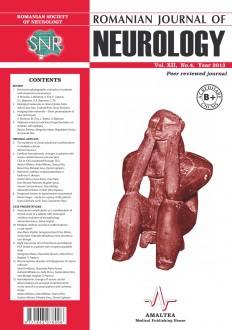SELECT ISSUE

Indexed

| |

|
|
|
| |
|
|
|

|
|
|
|
|
|
| |
|
|
HIGHLIGHTS
National Awards “Science and Research”
NEW! RJN has announced the annually National Award for "Science and Research" for the best scientific articles published throughout the year in the official journal.
Read the Recommendations for the Conduct, Reporting, Editing, and Publication of Scholarly work in Medical Journals.
The published medical research literature is a global public good. Medical journal editors have a social responsibility to promote global health by publishing, whenever possible, research that furthers health worldwide.
THE INCIDENCE OF VISUAL SUBCLINICAL MANIFESTATIONS IN MULTIPLE SCLEROSIS
ABSTRACT
Optic neuritis is often the initial manifestation in multiple sclerosis (15%). There is a significant percent of patients affected by clinically definite multiple sclerosis that report no ocular symptoms. Some of this patients complain of poor vision despite the 6/6 visual acuity with Snellen test. Subclinical visual abnormalities may be revealed by more sensitive measures of visual function. Alteration of visual evoked potential latencies associated with brain MRI lesion burden, standard achromatic perimetry and low-contrast letter acuity, may detect subclinical visual manifestations. In this study we compare the efficiency of electrophysiological test (visual evoked potential) and subjective tests (contrast sensitivity and standard achromatic perimetry) in detection of visual impairment in a population of asymptomatic patients with clinically definite multiple sclerosis.
Purpose. The detecting of subclinical impairment of visual function in a population of visual asymptomatic patients affected by clinically definite multiple sclerosis (MS) by using visual evoked potentials (VEPs), contrast sensitivity (CS), standard achromatic perimetry (SAP), magnetic resonance imaging (MRI), color vision test Ishihara, best corrected visual acuity (BCVA).
Methods. Eighteen eyes of nine patients affected by clinically definite MS, without visual disturbances and optic neuritis history. All the patients were recruited at the Department of Neurology of Emergency Universitary Hospital of Bucharest. Of the nine patients, 3 were male and 6 female. In all the cases the disease was in remission.
The tests used to detect the involvement of visual pathway were:
• VEPs (a P100 latency >115 ms)
• CS
• SAP (abnormal MD or PD)
• MRI (at least one demyelinating plaque along visual pathway)
• Color test Ishihara
• Best corrected visual acuity (BCVA)
• Biomicroscopy
• Ocular fundus examination after pupil dilatation
Results. From the 9 patients in the 29-47 year age group, VEPs was abnormal in 8 cases (88,8%), CS was abnormal in 8 cases (88,8%), SAP in 44,4%, color vision test Ishihara evidenced colour desaturation at 100% cases. Best corrected visual acuity, biomicroscopy and ocular fundus examination were normal in 55,5% cases.
Conclusions. In patients affected by MS with no history of optic neuritis and no visual symptoms, there is large prevalence of visual pathway involvement that can be detected by performing multiple tests. Only a combination of CS, VEPs and SAP can detect most cases of visual dysfunction associated with MS.
Keywords: multiple sclerosis (MS), visual evoked potential (VEP), contrast sensitivity (CS), standard achromatic perimetry (SAP)
